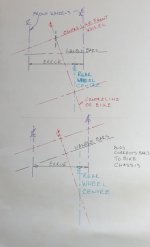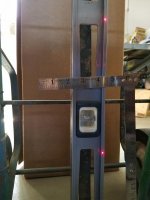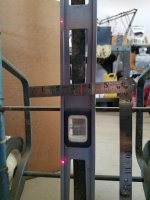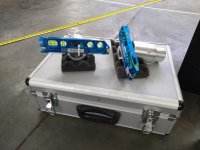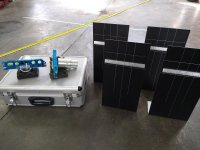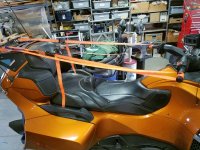PinkRosePetal
New member
I've separated this post from the previous one because it addresses the issue of aligning the front wheels to the rear wheel rather than aligning to the chassis centre line.
Since when running along the road your rear wheel will steer the bike until the rear wheel is running in the direction of travel it makes little difference to the bike which datum you use when setting your toe measurement.
The only difference, if BUDS is used to set the steering after the toe is set, is in the angle of the handlebars and the steering arm.
If your rear wheel happened to be perfectly in line with the chassis, as it should ideally be, then there will be no rear wheel steering at all. However, road camber will run the bike down hill on the camber so in practise there will likely always be some misalignment.
Note from the drawings below how the bike is guaranteed to be running slightly sideways if the rear wheel is not parallel to the chassis.
Obviously, in the drawing, rear wheel misalignment is exaggerated to clearly show the effect it has on the chassis angle.
Since when running along the road your rear wheel will steer the bike until the rear wheel is running in the direction of travel it makes little difference to the bike which datum you use when setting your toe measurement.
The only difference, if BUDS is used to set the steering after the toe is set, is in the angle of the handlebars and the steering arm.
If your rear wheel happened to be perfectly in line with the chassis, as it should ideally be, then there will be no rear wheel steering at all. However, road camber will run the bike down hill on the camber so in practise there will likely always be some misalignment.
Note from the drawings below how the bike is guaranteed to be running slightly sideways if the rear wheel is not parallel to the chassis.
Obviously, in the drawing, rear wheel misalignment is exaggerated to clearly show the effect it has on the chassis angle.

